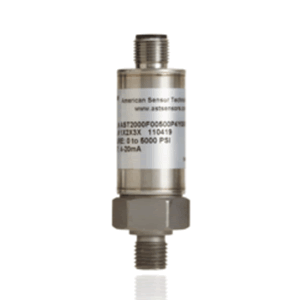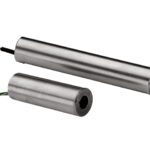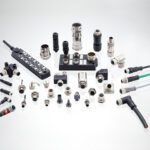Why Connector Giants Expand into Sensors
Is it for the sake of technology advancement, broader customer appeal, or just a good business opportunity? Bishop & Associates’ David Brearley looks at why connector giants expand into sensors.

This pressure transducer from TE looks a lot like an industrial circular connector.
You may have noticed there have been several acquisitions of sensor companies by connector companies in recent years.
TE Connectivity, for example, acquired Measurement Specialties, a $540-million company that manufactured sensors used in a variety of form factors and markets for pressure and acceleration. These can be used in industrial markets and even in devices on your wrist, in your pocket, or in your car. These devices are simple and sold as part of a broader offering of cables, connectors, and flex circuits. In 2014, TE also acquired American Sensor Technologies, a $20-million company that made sensors for harsh environments, to strategically participate in these markets. These devices are sophisticated and relatively high-value: Chemical, petroleum, and aerospace applications all need these solutions.
Amphenol acquired GE’s Advanced Sensor business at the end of 2013, including business units that make pressure, moisture, carbon dioxide, and temperature sensors. These devices are sold as raw components that an OEM might install on a board, as packaged devices, and even as completely enclosed handheld or wall-mounted carbon dioxide and moisture meters.
Several technologies, new and old, are used in sensor designs. Carbon dioxide detectors, for example, use an IR transmitter and receiver to detect particulates and can be used in wall- or duct-mounted applications to monitor and ensure air quality. These devices are in some home smoke detectors as well as a number of commercial and industrial applications where the monitoring of air quality is intrinsic to safety.
Thermistors measure temperature across a broad range of environments from cryogenic to very high temperatures found deep in the earth. These devices are passive with a single input and single output wire. They can be easily designed into a wide variety of monitoring and control applications.

Telair T9602 Temperature and Humidity Sensor from Amphenol Advanced Sensors looks remarkably like an overmolded cable connector.
MEMS (Microelectronic mechanical structures) use semiconductor manufacturing technology (photoimaging and etching) to form extremely small mechanical devices. This technology is ideal for creating very small sensors and strain gauges that react to stimuli like changing temperature, humidity, or pressure to generate either a change in resistance, an electrical current, or change in voltage. This change can be read by an electronic board and used to control a system that keeps the selected parameter within a range or as an alarm to notify the operator that something has occurred. Such devices are used across the industrialized world.
Because these devices can also be cheap and produced in very high volumes, we find more and more sensors in our world. Your cell phone, for example, has sensors for sound, magnetic fields, orientation, acceleration, pressure, temperature, light, etc. Applications can use these sensors to enhance the user experience. The same is happening in industrial, medical, petrochemical, and other consumer applications. Safety is another key market, monitoring air quality to detect smoke and fire or other hazardous substances.
Since the same OEM customers that buy connectors also buy sensors, it is an easy addition to the product portfolio for the sales people, reps, and distributors. Once a connector company becomes as large as TE or Amphenol, it is increasingly challenged to find unfilled, attractive connector niches to generate growth that exceeds that of the industry. Expansion into related component businesses like sensors makes sense, especially where effective sales channels already exist.
Connector companies see this as a logical extension of their existing businesses. They are able to acquire sensor technology and expertise and sell that capability as part of their product offerings to OEM customers and service industries. You will seldom find a sensor in the connector itself, and most of the sensors don’t actually have a connector on them either. Many are SMT-attached to a PCB or flex or are wirelessly connected for data. Work is underway to completely seal the sensor device and to use inductive power connections, a very interesting development path in the future.
So, the combination of new technology, cheap sensors, and ubiquitous Internet connections for the IoT (Internet of Things) means we should expect the sensor market to generate high growth and innovation, all attractive to the major connector companies. Expect to see more portfolio expansions into the world of sensors in the future.
[hr]






